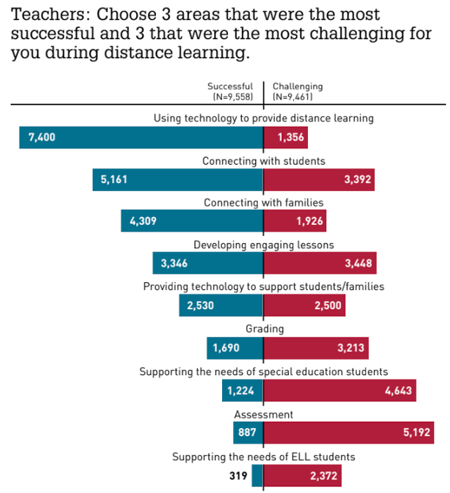Removing barriers and embracing relationships amid uncertainty
The goal of teachers building real, caring relationships with every student has never been more critical — and it has also never been more challenging. But as BARR Center executive director Angela Jerabek describes, we’ve learned much during the pandemic about how teachers can succeed.
By Angela Jerabek
Jerabek is the founder and executive director of BARR (Building Assets, Reducing Risks).
There was no shortage of stories about the tenuous state of schooling in this country as school districts began to reopen this fall.
Now that students are back in class — either in class or online — we continue to hear about the challenges of making sure that each and every student’s needs are met when they are physically dispersed. Every district is tackling important decisions to ensure they are implementing the right plan for their community at any given point in time. Although students are back to school, there are many strategies requiring continuous roll-out to make sure students have what they need for a successful school year.
 The hurdles of this past spring linger into the fall. School leaders are constantly reassessing models that work best for their district, knowing that swift changes may need to occur to contain the spread of the coronavirus in communities. Despite smoother transitions to online teaching, educators are still feeling upside down. The summer and first few weeks of school have provided teachers time to reflect on that experience and focus on how they can keep making improvements.
The hurdles of this past spring linger into the fall. School leaders are constantly reassessing models that work best for their district, knowing that swift changes may need to occur to contain the spread of the coronavirus in communities. Despite smoother transitions to online teaching, educators are still feeling upside down. The summer and first few weeks of school have provided teachers time to reflect on that experience and focus on how they can keep making improvements.
The University of Minnesota surveyed more than 13,000 teachers this summer. The survey found that teachers had numerous concerns about their own safety and that of their students, but that teachers had learned a great deal in their transition to online teaching.
Not surprisingly, when Minnesota teachers were asked to name their top three challenges during distance learning, connecting with students was well into the red zone (see chart). The survey showed that teachers had success in this area, but what we are hearing is that last year, they had already established relationships with these students before the transition to online learning.
Now they tell us the situation is different. They are deeply concerned about the difficulty of establishing and starting new relationships this fall — remotely. Educators are also concerned about equity and how to connect with all of their students and families. Yet, they are sure of the need to collaborate with their colleagues to ensure every student is seen, heard, and most importantly, supported.
For a copy of the Minnesota survey of teachers and their views about online education, click here.
It has never been more critical for teachers to build real, caring relationships with every student. It has also never been more challenging, but we’ve learned a great deal during the past several months about how teachers succeed. Educators can achieve success by fostering supportive relationships with their students. In order to create these connections, we first need to solve the issue of access to technology. Once technological issues are eradicated, educators and students can focus on the most vital need for this school year – relationships.
Eradicating technology barriers
Access to technology continues to be a prominent challenge this school year and is impacting families throughout the country. According to the Center on Reinventing Public Education, districts that have a higher percentage of students in poverty are most likely to begin their school year through remote learning.
Therefore, first and foremost, educators need to make sure every student has a device, is able to log on and understand the virtual platform being used by their school. Situations such as those occurring in Cleveland are common. A school district CEO in that area is still waiting for computers to arrive for their 6,000 students.
Not surprisingly, when Minnesota teachers were asked to name their top three challenges during distance learning, connecting with students was well into the red zone. The survey showed that teachers had success in this area, but what we are hearing is that last year, they had already established relationships with these students before the transition to online learning. Now they tell us the situation is different. They are deeply concerned about the difficulty of establishing and starting new relationships this fall — remotely. Educators are also concerned about equity and how to connect with all of their students and families.
Educators need to contact families directly and inquire as to the barriers they are experiencing. They then must brainstorm unique solutions needed for students to successfully log on. Schools must embrace multiple strategies to effectively communicate with families, including sending out surveys to understand families’ needs, creating instructional video tutorials, and making sure the district’s technology department is easily accessible.
When students and families spend less time worrying about their internet connectivity or device access, they can remove challenges in creating trusting relationships with teachers. By solving technology issues, students will feel more comfortable and therefore, better able to engage in learning and relationship-building.
Enhancing relationships
Removing technology barriers is critical for all students to develop strong relationships with their teachers, particularly those furthest from opportunity. While school has shifted to these different solution-based models for the first time in the history of education, educators are up to the task. In an unsteady time, relationships stand as the one constant variable to transform a student’s life. Educators were abruptly thrown into school closures and online learning last spring.
However, during the past few months, teachers have thought, studied, and consulted extensively, perhaps obsessively, about how to improve this fall. Whether it is teachers making an effort to consistently contact each family, school leaders providing families with an allotted time to connect, or the technology department sending out additional surveys to gauge needs, making the effort to personally connect with families is critical to success.
The details may vary, but the underlying commitment to establishing and sustaining relationships with each and every student is the single thing that will unite us and make us stronger. That premise, that promise — to connect with and engage every student — establishes a strong foundation for any version of a school’s operating model to meet the needs of its students.
NOTE: BARR (www.barrcenter.org) is a model that improves the education system with deepened relationships and a data-driven, personalized and supportive approach. BARR aligns students, teachers, staff, and families with a unified culture of support and success to build stronger schools and communities.
__________

Angela Jerabek began her career in education as a licensed K-12 teacher and secondary school counselor. Now, Angela serves as the founder and executive director of BARR Center, a national school improvement network based in Minneapolis that is delivering positive results in schools across the United States.
Chart credit: Pekel, K., Gibbons, K., Parr, A., McKevett, N., Potter, L., & Evenson, A. (2020, June). Minnesota PK-12 Distance Learning Survey: Experiences of Minnesota Educators: March-June 2020. University of Minnesota. https://drive.google.com/file/d/11mv9Fhmiq-L3U3KRWj_4niGbxw2Ar505/view
See all columns from the Center.
October 15, 2020

